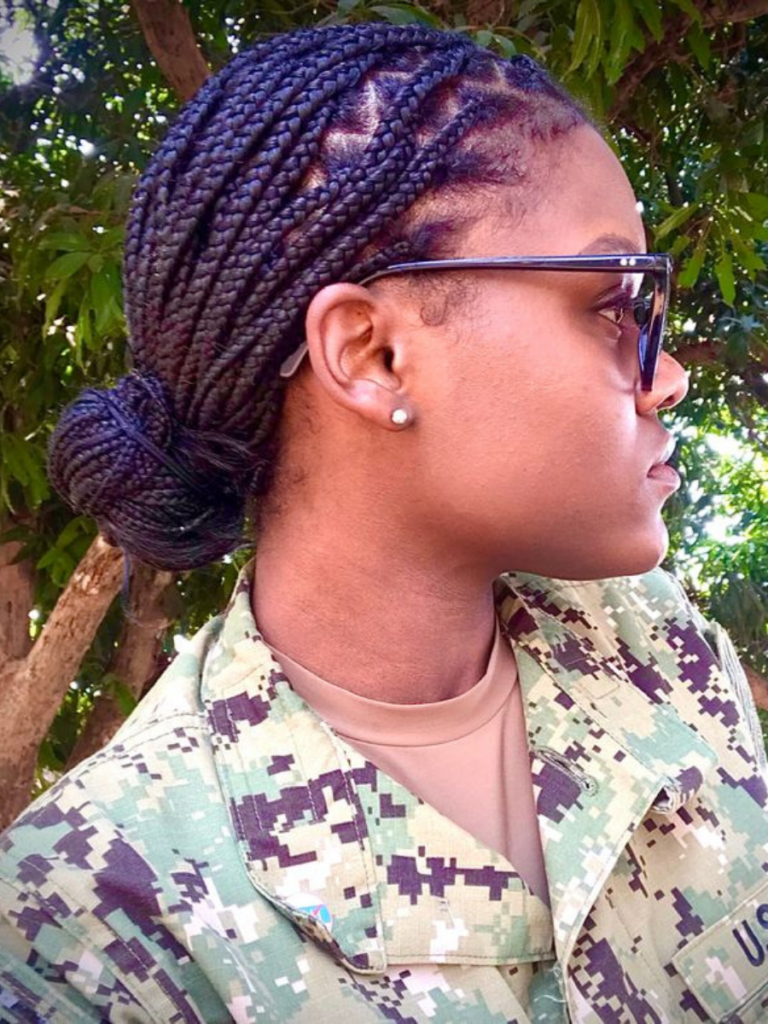Are you curious to know if braids are allowed in the military? Yes, the military permits braids. Women can now wear their hair in a bun, single ponytail, two braids, or a single braid, twists, or cornrows can be braided, or a ponytail; and braids or a ponytail can go all the way down to the bottom of the shoulder blades.
Read on below to learn about several factors of braids and know where you can do braids.
Can you wear braids in basic training?
No, you can’t wear braids in the basic training. Basic training does not permit wigs weave, feed-in braids, or any other sort of extensions. However, depending on your drill sergeant, you may be able to use extension hair created expressly for braiding.

Hair that hangs past the fastening attachment can be braided or let to hang freely. In-Service, Working, and PT uniforms, a single braid, French braid, or single ponytail are permitted. The following guidelines apply to ponytail hairstyles worn while wearing a US Navy uniform.
Yes, females can have bangs in the navy. Long hair, especially braids, must be pinned or tied to the head neatly. When wearing bangs, they must not fall below the brows. The length of the hair must be adequate to hide the scalp (barring documented clinical issues).

Women, except the Navy, are not required to get their hair cropped. Women must wear their hair so that it does not extend past the bottom of the collar and is not below the brows when in uniform (which is all time in basic training).
Which Braids are not Cultural Appropriation?
In recent years, the debate over braids and braided hair has erupted into a raging debate. While some may regard them as merely a hairstyle, others believe them as an integral part of their culture and heritage. Cultural appropriation occurs when someone has their hair braided in a certain fashion but does not belong to that culture. However, French and Dutch, and any other basic braids are not cultural appropriations.
When are braids cultural appropriation?
White women frequently adopt African-American culture as an accessory and a personality attribute. Culture is not a character flaw. Black culture is responsible for box braids, cornrows, long acrylic nails, and weaves. Women braided maps and signals into their hair during slavery so that other slaves on the plantation could find directions without being discovered by the slave masters.
Cornrows are typically thought of as urban by now, yet they have impactful historical importance. White women view Cornrows as trendy and original. On the other hand, black women view them as hostile and unapproachable. Many celebrities now wear wigs and are celebrated for making them a part of mainstream culture.
Black women used to be dubbed bald and had their wigs pulled from their heads, but now many celebrities wear wigs and are praised for making them a part of mainstream society. To dismiss African hair simply as a hairdo is demeaning. It is a political statement and a sign of black pride. For years, African hairstyles were chastised and ridiculed, and people praised white women who accepted them only.
People refer to these white women as trailblazers, trendy, and funky. The terms that people did not use to describe a black woman who similarly wore her hair. Negative prejudice and racism have also resulted in black men and women losing their jobs.

Can Braids cause breakage?
Braids can cause breakage. If you pull your hair back too firmly, it can break away from its roots, causing splitting, hair weakening, and follicle damage, therefore keeping the braid slack from the start. Extremely tight braids produce Repeated straining on hair follicles and, this causes tensile stress.
Which braids are best for short black hair?
Short hair looks best with cornrows, box braids, and micro braids. You may not require extensions with these styles, or if you do, they do not have to be lengthy or huge extensions.
Can short afro hair be braided?
Yes, short afro hair can be braided. African-Americans with textured hair are more likely to sport short afros. Afros are frequently braided in cornrows when people desire to tie them. Cornrows are braids that run vertically, horizontally, or diagonally close to the scalp, resembling rows of corn in a field.
Cornrow braids are a low-maintenance hairstyle that protects your hair from breaking. Because of the length of the hair, braiding short afros might be difficult. Knowing how to braid your short afro can help you produce professional-looking braids.
Which braids hurt the least?
Knotless braids hurt the least. Smaller braids (like cornrows) are formed with a lot of strain and can thus cause more breaking; larger braids (like cornrows) are created with a lot of tension and can therefore cause more breakage.
Are knotless braids less painful?
For decades, box braids have been a go-to trend for women of color. Many people are now choosing a knotless version. Traditional box braids are easy to maintain, protect natural strands from daily manipulation, and look beautiful.
Pain, a heavyweight, and vulnerability to buildup and infection among the knots generated at the base of each braid are just a few of the harsh realities that box braids can bring.
Hair loss or irritation around the roots of each braid is possible, depending on your hair type and how you maintain the style. Knotless braids are similar to traditional box braids but do not have a knot.
Using this feed-in approach, the braid begins with your natural hair and then adds extension hair midshaft for thickness and length.
Fashion is changing, variety of elements influences it. Hair braids are timeless and universal, but white people need consciousness of why they irritate people of color. They should not claim to be the creators of something that has existed for hundreds of years and that their forefathers worked so hard to suppress and destroy.
Lastly, check out the mane caper shop.


